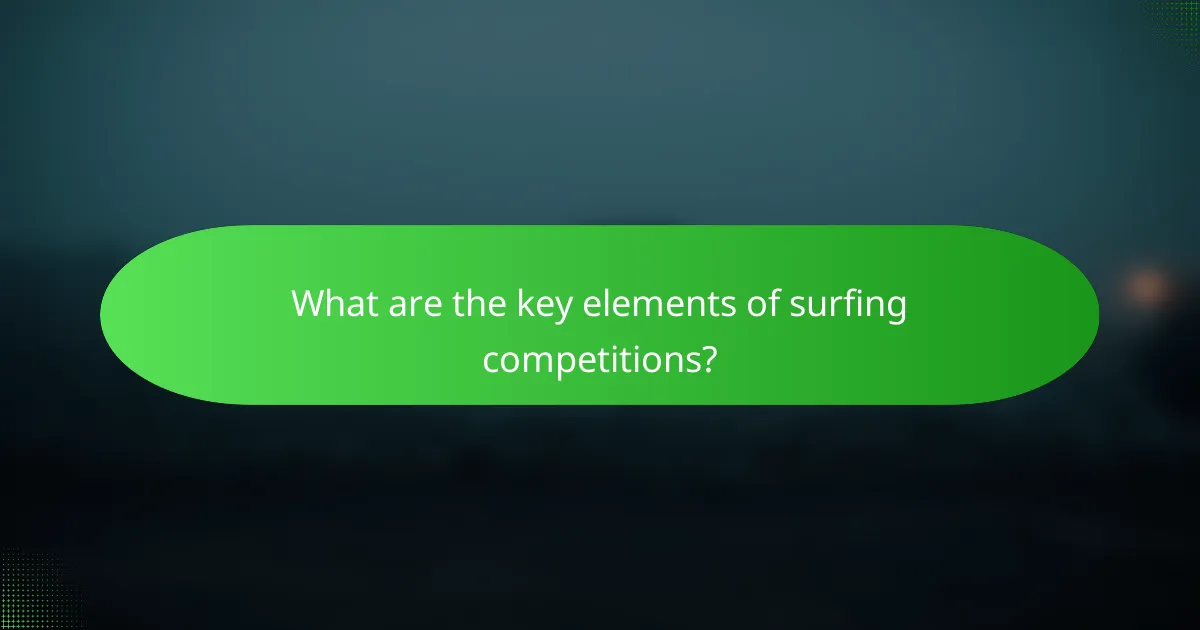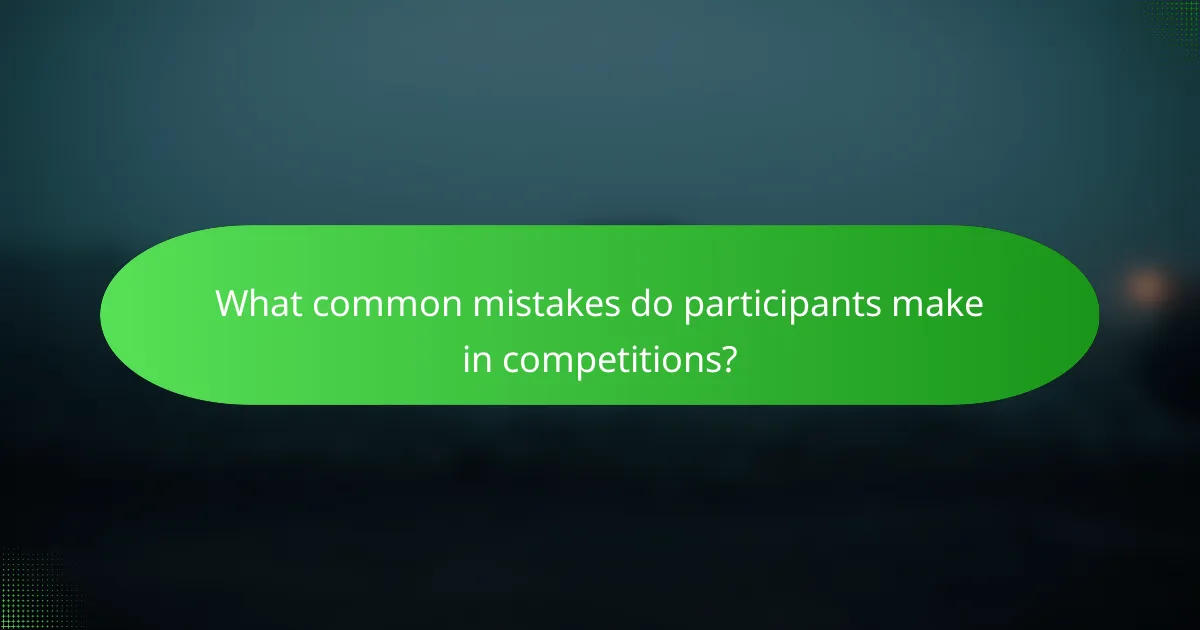Surfing competitions provide opportunities for skill enhancement and personal achievement while fostering community engagement. Key elements include wave quality, scoring criteria, and heat formats that influence performance. Participants gain insights into emotional resilience and strategies for improvement. Understanding common mistakes can help surfers optimise their competition experience.

What are the key elements of surfing competitions?
Key elements of surfing competitions include wave quality, scoring criteria, participant skill levels, and heat formats. Wave quality directly impacts performance, while scoring criteria assess manoeuvres and style. Participant skill levels vary, influencing competition dynamics. Heat formats determine the structure of the event, affecting strategy and outcomes.
How do competition formats influence participant performance?
Competition formats significantly impact participant performance by influencing stress levels, strategy choices, and overall engagement. For example, head-to-head formats may enhance motivation through direct competition, while judged formats can lead to anxiety over subjective evaluations. The structure of heats and elimination rounds also affects how surfers pace themselves and manage energy. Additionally, unique attributes like local conditions and crowd dynamics can further shape performance outcomes.
What judging criteria are used in surfing contests?
Surfing contests use criteria such as wave quality, difficulty of manoeuvres, variety of tricks, and overall flow. Judges assess the surfers’ ability to ride the wave and execute techniques effectively. Each criterion is weighted to determine the final score, reflecting both the technical skill and artistic expression of the performance.
Which organizations regulate surfing competitions globally?
The World Surf League (WSL) and the International Surfing Association (ISA) are the primary organizations regulating surfing competitions globally. WSL oversees professional surfing events, while ISA governs amateur competitions and promotes surfing worldwide. Other regional bodies may also influence local events.

What insights can be gained from participant experiences in surfing competitions?
Participant experiences in surfing competitions reveal valuable insights into performance, emotional resilience, and community dynamics. These insights help improve training methods and enhance competitive strategies. For instance, emotional responses to competition pressure can inform mental preparation techniques. Additionally, shared experiences foster a sense of community among surfers, promoting collaboration and support. Understanding these aspects can lead to a more enriching and effective competitive environment.
How do competitors prepare mentally and physically for events?
Competitors prepare mentally and physically for surfing events through rigorous training, visualization techniques, and tailored nutrition plans. Mental preparation includes focusing on strategies to manage anxiety and enhance concentration. Physical training typically involves strength, endurance, and flexibility exercises specific to surfing. Nutrition plays a critical role, with many surfers opting for balanced diets rich in carbohydrates and proteins to optimise performance.
What challenges do participants face during competitions?
Participants in surfing competitions face several challenges that can impact their performance. These include unpredictable wave conditions, intense competition, mental pressure, and physical fatigue.
Unpredictable wave conditions can vary greatly, affecting strategy and execution. Intense competition heightens pressure, leading to anxiety and performance issues. Mental pressure can distract surfers, making it difficult to focus on their technique. Physical fatigue from long heats and demanding manoeuvres can hinder endurance and performance.
Overall, these challenges require surfers to develop resilience and adaptability to succeed in competitions.
How do regional differences impact participant strategies in competitions?
Regional differences significantly shape participant strategies in surfing competitions. Local wave conditions, cultural influences, and access to training facilities dictate how surfers prepare and compete. For instance, surfers from coastal regions with consistent waves often develop different techniques compared to those from areas with variable conditions. Additionally, cultural attitudes towards competition can affect mental preparedness and approach. Surfers in regions that emphasise community and collaboration may adopt more supportive strategies, while those in highly competitive environments might focus on individual performance. Understanding these regional nuances enhances strategic planning for participants.

What are the benefits of participating in surfing competitions?
Participating in surfing competitions offers numerous benefits, including skill enhancement, community engagement, and personal achievement. Competitors often experience improved techniques through rigorous practice and feedback.
Engagement with a vibrant surfing community fosters connections and friendships among enthusiasts. Competing can also boost self-confidence and motivation, pushing individuals to set and achieve personal goals.
Additionally, surfers gain exposure to diverse surfing styles and strategies, enriching their overall experience. Competitions often provide opportunities for sponsorships and career advancement in the surfing industry.
How do competitions enhance skill development for surfers?
Competitions significantly enhance skill development for surfers by providing structured environments for practice and feedback. They foster goal setting and motivation, pushing participants to improve their techniques.
Competitions also expose surfers to diverse conditions, enhancing adaptability. This exposure can lead to unique learning experiences, as surfers face varied wave types and competitors. The competitive atmosphere encourages surfers to refine their strategies and performance under pressure, which is crucial for skill advancement.
Additionally, competitions often include coaching and mentorship opportunities, allowing surfers to gain insights from experienced professionals. These interactions can provide valuable tips that directly contribute to skill enhancement.
Overall, participation in surfing competitions cultivates a growth mindset, essential for continuous improvement in the sport.
What networking opportunities arise from competing?
Competing in surfing competitions creates valuable networking opportunities among participants. These events foster connections with fellow surfers, industry professionals, and sponsors. Participants can share insights, collaborate on projects, and build relationships that may lead to sponsorship deals or career advancements. Additionally, competitions often attract media attention, providing exposure that can enhance personal branding and open doors to new opportunities in the surfing community.
How can participation in competitions boost a surfer’s career?
Participation in competitions can significantly enhance a surfer’s career by providing exposure, experience, and networking opportunities. Competing against skilled peers sharpens techniques and boosts confidence. Success in competitions often leads to sponsorships, increasing financial support for training and travel. Additionally, competitions can enhance a surfer’s visibility, attracting media attention and fan engagement. Overall, these factors contribute to career advancement and personal growth within the surfing community.

What unique experiences do top competitors share?
Top competitors in surfing share unique experiences that enhance their performance and camaraderie. They often emphasise the importance of mental resilience, adaptability to varying wave conditions, and a strong support network. These attributes foster a competitive spirit and personal growth. Additionally, many participants highlight the thrill of competing in diverse locations, which contributes to their passion for the sport.
Which personal stories highlight the dedication of elite surfers?
Elite surfers demonstrate remarkable dedication through personal stories of resilience, training, and competition. For instance, Kelly Slater’s commitment to surfing since childhood showcases his relentless pursuit of excellence. Bethany Hamilton’s inspiring return to the sport after a shark attack highlights her determination and passion. These narratives illustrate how elite surfers overcome challenges and maintain their focus on achieving greatness.
How do top surfers balance competition with personal life?
Top surfers balance competition with personal life by prioritising time management and setting clear boundaries. They often schedule training sessions around family commitments and social activities. Many surfers emphasise the importance of mental health, using mindfulness techniques to cope with competition stress. Additionally, they maintain strong support networks, including family and friends, to help navigate the pressures of their sport. Balancing travel for competitions with home life is crucial, as it allows them to stay connected with loved ones.
What rare opportunities do elite competitors encounter in their careers?
Elite competitors in surfing encounter rare opportunities such as exclusive sponsorship deals, access to elite training facilities, and participation in high-stakes competitions. These experiences often lead to unique networking chances with industry leaders. Additionally, elite surfers may gain insights into innovative techniques and cutting-edge equipment. Such opportunities can significantly elevate their careers and influence their standing in the sport.

What common mistakes do participants make in competitions?
Participants in surfing competitions commonly make mistakes such as poor wave selection, inadequate preparation, and lack of focus. These errors can significantly impact their performance and overall scores.
Poor wave selection often leads to missed opportunities for scoring high points. Many participants fail to identify the best waves for their skill level, resulting in suboptimal rides.
Inadequate preparation includes not practising enough or failing to understand the competition format. This can lead to confusion during heats and missed chances to showcase skills.
Lack of focus, often due to nerves or distractions, can cause participants to lose sight of their strategy. Staying mentally sharp is crucial for executing manoeuvres effectively.
How can surfers avoid typical pitfalls during events?
Surfers can avoid typical pitfalls during events by focusing on preparation, strategy, and mental resilience. Proper training and understanding the competition format are crucial.
1. Research the event conditions, including wave patterns and weather forecasts.
2. Develop a clear competition strategy tailored to strengths and weaknesses.
3. Manage time effectively to allow for practice and rest.
4. Stay mentally focused and maintain a positive mindset to handle pressure.
5. Communicate with coaches and peers for feedback and support.
6. Adapt to changing conditions quickly to optimise performance.
What strategies can enhance performance and reduce errors?
Improving performance and reducing errors in surfing competitions involves focused strategies. Key techniques include mental preparation, physical training, and equipment optimisation.
Mental preparation enhances focus and reduces anxiety. Visualization techniques allow participants to mentally rehearse their performance. Physical training, including strength and endurance exercises, improves overall fitness and agility on the waves. Equipment optimisation, such as selecting the right board and fins, can significantly impact performance.
Additionally, analysing past performances helps identify areas for improvement. Athletes should review competition footage to learn from mistakes. Engaging with coaches for feedback and strategy refinement also contributes to enhanced performance.
What expert tips can improve a competitor’s chances of success?
To improve a competitor’s chances of success in surfing competitions, focus on training, strategy, and mental preparation. Consistent practice enhances skill and technique. Analysing previous performances helps identify strengths and weaknesses. Mental resilience is crucial for handling competition pressure. Nutrition and physical fitness play vital roles in performance.
1. Establish a rigorous training schedule.
2. Review past competition footage for insights.
3. Incorporate mental conditioning exercises.
4. Maintain a balanced diet tailored for energy.
5. Engage in cross-training to improve overall fitness.
6. Develop a pre-competition routine to enhance focus.
